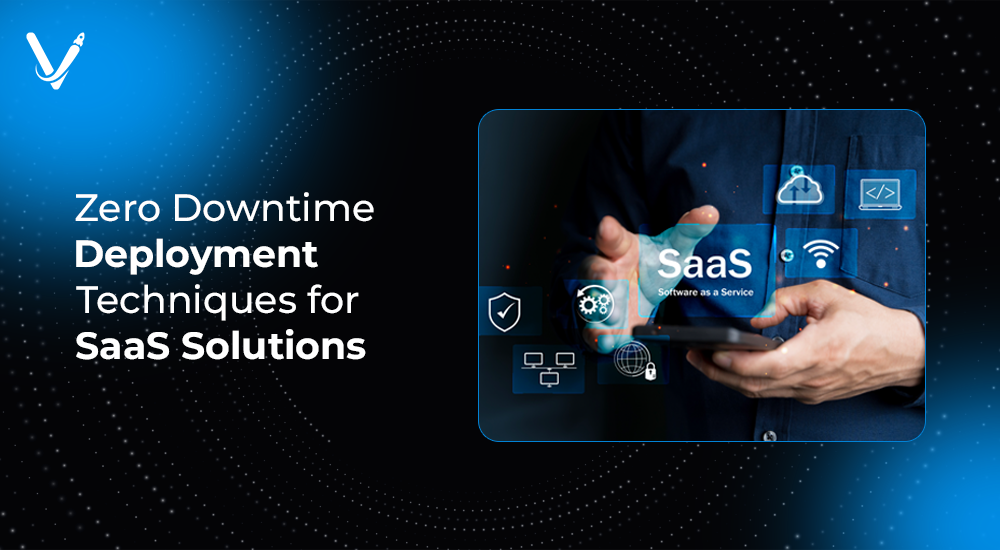Zero Downtime Deployment Techniques for SaaS Solutions


- Apr 24, 2025



In today’s digital-first world, users demand uninterrupted access to the software and services they rely on. For SaaS (Software-as-a-Service) providers, meeting this expectation isn't just good practice—it’s business-critical. Even a momentary lapse in service availability can lead to revenue loss, user dissatisfaction, or damage to brand reputation.
To stay competitive and trustworthy, SaaS platforms must evolve without interruption. That’s where zero downtime deployment comes into play. It refers to the process of deploying application updates and improvements without causing any service disruption for users.
Whether you're managing a mission-critical platform or a rapidly growing SaaS product, understanding and implementing zero downtime techniques can elevate your development and operations workflow. This guide explores the key methods, infrastructure choices, and best practices to help you achieve zero downtime deployments effectively.
Downtime can have serious repercussions, particularly in highly competitive SaaS markets. A few minutes of unavailability can lead to thousands of dollars in lost revenue, especially for mission-critical applications. More importantly, downtime erodes user trust. In sectors such as fintech, e-commerce, and healthcare, even a few seconds of downtime can lead to regulatory issues or operational paralysis.
Customers expect 24/7 service availability. In a SaaS model, the vendor is responsible for maintaining uptime. This responsibility means that developers and DevOps teams must adopt deployment strategies that eliminate or minimize service interruptions.
To achieve zero downtime, teams must understand and implement several key concepts:
Immutable Infrastructure: Instead of modifying existing servers, new ones are provisioned and deployed with every change. This ensures consistency and predictability.
Blue-Green Deployments: Maintain two production environments and switch traffic from the old to the new version once testing is complete. Canary Releases: Gradually roll out updates to a small subset of users to monitor for issues before a full release. Feature Toggles: Deploy code with features turned off, and enable them later through configuration. Database Migration Strategies: Ensure schema changes do not disrupt the current application. CI/CD Automation: Automate testing, building, and deployment to reduce human error and increase reliability.
Achieving zero downtime isn't about using a single deployment method—it's about choosing the right combination of techniques that align with your system architecture, team workflow, and user base.
Modern DevOps practices offer several proven strategies to help SaaS teams roll out updates safely, incrementally, and without disrupting the user experience. In this section, we'll explore the most widely adopted zdd techniques, how they work, and when to use each one effectively.
In a blue-green deployment model, you have two identical environments: one (blue) currently serving production traffic, and another (green) ready with the new version. Once the new version is thoroughly tested in the green environment, traffic is switched from blue to green. If issues arise, traffic can be reverted to blue immediately.
Benefits:
Considerations:
Canary releases involve rolling out the new version to a small segment of users. Monitoring tools are used to track metrics like response time, errors, and system load. If everything goes well, the release can be expanded gradually.
Benefits:
Considerations:
Rolling updates incrementally replace old instances with new ones. For example, in a Kubernetes environment, pods are updated in a staggered fashion.
Benefits:
Considerations:
Feature flags allow developers to merge new features into the main codebase without exposing them to users. Features can be turned on or off without deploying new code.
Benefits:
Considerations:
One of the most complex—and often risky—parts of achieving zero downtime deployment is managing database schema changes. Unlike application code, databases are stateful and shared resources, which makes updates particularly sensitive. A poorly planned schema change can bring your entire service down or introduce data corruption.
To safely evolve your database alongside your application, several key strategies are commonly used:
Backward-Compatible Migrations
When updating your schema, it's crucial to ensure that both the existing and the updated versions of your application can work seamlessly with the new structure.
This often means breaking migrations into multiple stages—first adding new columns or tables without removing the old ones, and updating code to use the new schema only after it's stable.
Avoid Destructive Changes During Deployment
Dropping a column or renaming a table might seem harmless during development, but in production, such actions can cause catastrophic failures.
Always phase out obsolete schema gradually, and only remove elements once you're certain they’re no longer in use.
Use Online Migration Tools
Tools like gh-ost (GitHub Online Schema Transmogrifier) and pt-online-schema-change from Percona are designed for live environments.
They allow you to modify large tables without locking them, significantly reducing the risk of downtime during migrations.
Dual-Write Strategies
During transitional periods, you may need to write data in both the old and new formats to ensure backward compatibility. This adds some complexity but provides a safety net for rollback and verification.
Versioned APIs for Data Access
If your services communicate via APIs to retrieve or modify data, consider versioning those interfaces.
This ensures that changes to data structures or behavior won’t unexpectedly break dependent services or clients.
Database migrations require the same level of testing and rollout discipline as your application code. With proper tooling and a carefully staged approach, you can evolve your data model without introducing risk or downtime.
Implementing zdd is not just about using the right tools—it’s about adopting the right engineering mindset and operational discipline. Here are some time-tested best practices that can make all the difference:
Following these best practices doesn't just reduce the chance of downtime—it builds a more resilient and agile deployment culture within your team.
Even with the best intentions, many teams fall into traps that compromise their zero downtime goals. Here are some common pitfalls to watch out for:
Ignoring Database Migration Planning
Schema changes without compatibility planning can break your application. Treat database updates with the same caution and rigor as application deployments.
Lack of a Rollback Strategy
If a deployment goes sideways, you need a clear and fast rollback process. Whether it’s rolling back the code, toggling off a feature flag, or redirecting traffic, preparation is key.
Insufficient Monitoring and Alerting
If you’re not watching your system, you won’t know when something goes wrong—until your users tell you. Poor observability turns small bugs into major outages.
Overlooked Service Dependencies
In a microservices architecture, changes in one service can ripple into others. Always map out dependencies and coordinate releases accordingly to avoid cascading failures.
Neglected Feature Flags (Flag Debt)
Feature toggles are powerful but need cleanup. Unused or stale flags can clutter your codebase and introduce confusion or even bugs over time. Regularly audit and remove obsolete flags.
Avoiding these pitfalls is about foresight, coordination, and a healthy respect for complexity. Zero downtime isn’t just a goal—it’s a habit.
Netflix: Known for advanced canary deployment practices and resilient microservices architecture. They use Spinnaker for safe, automated rollouts.
Shopify: Implements feature flags, automated testing, and phased rollouts. Known for deploying hundreds of times per day with minimal impact. Facebook: Uses dark launches and feature toggles extensively. Their deployment system supports gradual rollout and rapid rollback.
These companies demonstrate that zero downtime is not just achievable but essential for scaling and reliability.
Zero downtime deployment is a critical capability for modern SaaS businesses. It ensures uninterrupted service delivery, boosts user satisfaction, and maintains business continuity. While it requires investment in tools, infrastructure, and process discipline, the payoff is significant. Teams should start with basic techniques like blue-green deployment or feature flags and gradually evolve towards more advanced strategies like canary releases and rolling updates.
Have you implemented zero downtime deployment in your SaaS application? Share your experiences and tips in the comments. For more articles on DevOps, CI/CD, and SaaS best practices, subscribe to our blog and follow us on social media. Let’s build better, together. Get in touch with us today!
Copyright © 2025 Vasundhara Infotech. All Rights Reserved.